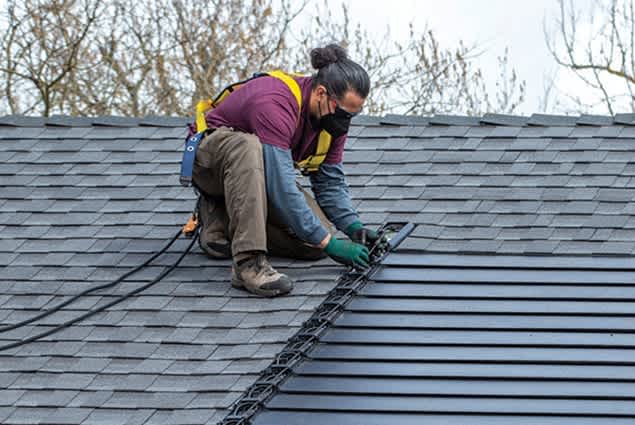Key Takeaways
- Solar roofing offers substantial energy savings and environmental benefits.
- Technological advancements are enhancing the efficiency and aesthetics of solar roofing.
- Initial costs are high, but long-term benefits outweigh expenditures.
- Incorporating solar roofing boosts the resale value of your home.
Table of Contents
- What is Solar Roofing?
- Benefits of Solar Roofing
- Technological Advancements
- Financial Considerations
- Installation Process
- Maintenance Tips
- Boosting Property Value
- Real-Life Success Stories
What is Solar Roofing?
Solar roofing integrates photovoltaic panels directly into roof tiles or shingles, seamlessly converting solar energy into electricity for home use. It’s a sustainable solution that caters to the growing need for renewable energy sources.
Unlike traditional solar panels mounted on the roof, solar roofing incorporates the panels directly into the roofing materials, creating a sleeker look. This innovation has made solar roofing an attractive option for homeowners seeking functionality and aesthetics. Solar roofs can come in various styles and colors, giving homeowners more options to match their home’s architectural design.
Benefits of Solar Roofing
The shift to solar roofing brings a myriad of benefits. Not only does it cut down on energy bills, but it also reduces carbon footprints, contributing significantly to environmental conservation. Residential solar installations have driven job growth in renewable energy industries, as stated by the Solar Energy Industries Association. Opting for a reputable solar roof company ensures quality installation and lasting benefits.
The energy generated by solar roofing can power various household appliances, significantly reducing dependence on non-renewable energy sources. Additionally, in numerous regions, homeowners have the ability to sell any extra energy produced back to the grid through net metering policies, which helps to increase their cost savings even more. Solar roofing systems often have warranties lasting up to 25 years, ensuring long-term reliability and value.
Technological Advancements
In recent years, there have been significant advancements in solar roofing technology. Innovations like bifacial solar panels and improved energy storage solutions have magnified the efficiency of solar roofs. Bifacial panels capture sunlight from both sides, increasing energy production, while advanced batteries allow homeowners to store energy for use during cloudy days or nighttime.
These enhancements ensure better energy capture and storage, propelling the industry forward. Moreover, advancements in materials science have yielded more durable and weather-resistant solar roofing tiles capable of withstanding harsh environmental conditions. This has made solar roofing a versatile option for various climates and geographical regions. Additionally, emerging technologies like solar skins—designed to blend in with traditional roofing materials—make solar roofs even more aesthetically pleasing.
Financial Considerations
While the initial investment in solar roofing can be substantial, government incentives and tax rebates help offset costs. Federal tax credits and state-specific incentives can significantly lower the overall expenditure, making solar roofing more accessible to a broader range of homeowners. OOver the years, the cost-effective choice becomes clear due to the savings on energy and the possibility of boosting property value. Explore the cost-effectiveness of solar roofing.
Additionally, financing options are available from various financial institutions and solar roof companies, making it easier for homeowners to manage the upfront costs. Numerous companies also provide leasing opportunities, which enable homeowners to take advantage of solar energy without the upfront cost. Over time, a lot of homeowners discover that the initial cost is worth it due to the energy savings and higher property value.
Installation Process
Installing solar roofing involves several key steps. First, a detailed assessment of the roof’s structural integrity is necessary. This ensures the roof can support the additional weight of the solar panels or shingles. Following this, the photovoltaic panels or solar shingles are installed, ensuring they are optimally positioned for maximum sunlight exposure. Finally, the system is connected to the home’s electrical grid, ready to harness solar power.
Expert installation guarantees that the system is correctly and safely installed, enabling homeowners to reap the rewards of solar power without any complications. Choose a certified installer to ensure compliance with local building codes and regulations. The process typically takes a few days to a week, depending on the size and complexity of the installation. Once installed, the transition to solar energy is seamless, with minimal disruption to the household.
Maintenance Tips
Maintaining a solar roof is relatively easy. Routine cleaning of the panels is essential to prevent dust accumulation and ensure efficient energy absorption. For optimal performance, cleaning the panels every few months is recommended, especially in areas with heavy dust or pollen. Additionally, a periodic inspection by professionals will help detect and address any wear and tear, ensuring long-lasting performance.
Basic upkeep activities, like removing debris and inspecting for harm post-extreme weather, are beneficial for maintaining the operational efficiency of the solar roof. Most solar roofing systems require minimal upkeep, making them an attractive option for busy homeowners. With proper maintenance, a solar roofing system can continue to generate clean energy efficiently for decades, providing substantial long-term benefits.
Boosting Property Value
Adding solar roofing to a home can significantly increase its market value. Prospective buyers are often willing to pay more for a property with energy-efficient features, recognizing the long-term savings and environmental benefits. Recent studies have shown homes with solar installations sell faster and at higher prices than those without. The National Renewable Energy Laboratory notes that homes with solar panels sell 20% faster and for 17% more money.
Moreover, as energy costs continue to rise, having a solar roofing system in place can be a strong selling point, appealing to environmentally conscious buyers looking for sustainable living solutions. Integrating renewable energy systems like solar roofing is becoming desirable in the real estate market, potentially giving sellers a competitive edge.
Real-Life Success Stories
Many homeowners have successfully transitioned to solar roofing and reaped numerous benefits. One such example is a family in California who reported a 50% reduction in their energy bills within the first year of installation. Their story showcases the tangible advantages of embracing solar technology.
Another inspiring example is a community project in Texas where solar roofing was integrated into multiple homes, significantly reducing the neighborhood’s overall energy consumption and fostering a sense of communal pride in sustainable living. These success stories demonstrate the practical benefits of solar roofing and underscore its potential to transform the way we think about energy consumption.




